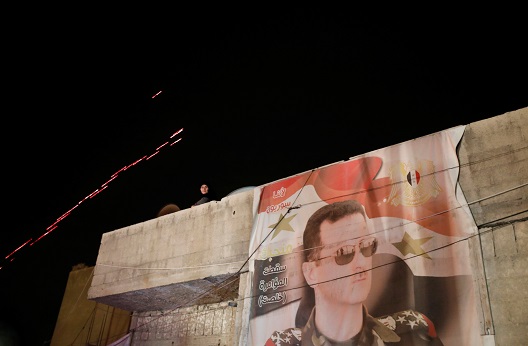World leaders once again accused the Syrian regime of resorting to a chemical weapons attack, killing dozens in Douma on April 8. While the regime regularly uses chlorine—a choking agent that causes respiratory problems, vomiting, and death—this attack involved something deadlier. Witnesses described symptoms that mirror those who fell victim to sarin gas, but this likelihood remains unconfirmed. Syrian regime supporters have questioned these accusations, rhetorically wondering why Bashar al-Assad would risk another international backlash against the war effort at a time when the international community appears resigned to his eventual victory. The answer lies in the urgency Assad faces in ending the conflict as quickly as possible.
The Assad regime first used sarin in 2013 on Ghouta, reportedly killing more than 1,000 people. Despite having crossed then-President Barack Obama’s red line, he decided not to engage militarily, opting instead for a political agreement in which the regime would dispose of its entire chemical weapons stock—an agreement that obviously failed. The regime tested the newly inaugurated US President Donald Trump in April 2017, using sarin gas on Khan Shaykhun (south of Idlib), killing an estimated 74 people and injuring 557 others. Trump’s reaction surprised many: he ordered US forces to bomb the Shayrat Airbase, the reported source of the sarin gas attack.
Trump did not press the attack and Assad now seems willing—perhaps even needs—to test the chemical red-line again. Trump announced on April 3 that he wanted to withdraw from Syria, perhaps unintentionally signaling a greenlight for the Syrian regime. Nonetheless, the regime clearly reacted overzealously. By bombing Douma immediately after the announcement, the regime risks a US reaction and prolonged US presence in Syria. Secretary of Defense General James Mattis stated today that the Pentagon may still consider an air strike against the Syrian regime in response; President Trump has said that Assad will have a “big price to pay” for the attack and that he will make a decision in the next 24 to 48 hours. Despite the rhetoric, the United States can do little to alter the course of the war. The United States remains unwilling to invest in regime change or place its full military might in support of the fractious opposition while Bashar al-Assad enjoys the full support of Russia and Iran. Any US strike against the Syrian regime or its allies would only aim to save face rather than alter the war’s trajectory.
That the Assad regime wants to retest its limits only presents part of the picture. After nearly seven years of complex conflict, the Syrian economy teeters on the edge of collapse. Assad needs to end the civil war quickly to begin rebuilding the country and paying back hefty debts to his international backers. Each day the war continues marks another day in which markets remain unstable, infrastructure crumbles, education remains stagnant (or nonexistent), and the currency continues its downward spiral. International sanctions add additional pressure to a country depleted of its human resources by the death of 500,000 people and the displacement of about half the country’s population.
Iran and Russia have spent an exorbitant amount of time, money, and resources—including international reputation—protecting Assad’s claim to power. Without them the regime would have likely have faced either defeat or a stalemate early in the war. Assad owes them a swift victory and compensation; he undoubtedly faces pressure to end the war by any means necessary. Only by regaining control of the country and starting the potentially lucrative reconstruction projects can Assad recoup their losses. Restoring order and economic recovery in Syria, however, would take decades.
Assad’s answer? Chemical weapons of mass death and terror, but not destruction. While barrel bombs deliver similar psychological blows to his rebel opposition, they remain relatively limited in scope compared to more sophisticated weapons, they lack precision, and the collateral damage to buildings, roads, and other essential infrastructure needed for economic revitalization places additional costs on the regime after it takes over. Those left in Syria have done everything they can to adapt to barrel bombs—using early warning systems, removing windows, and building structures underground. Assad needs a deadlier weapon; the only cost effective option available involves chemical weapons. They kill more people than barrel bombs, striking more terror into local populations and forcing them to submit all the quicker.
Assad’s lack of ground forces needed to recapture and control Syria also incentivizes the use of chemical weapons. His default reliance on a combination of siege tactics and aerial bombardment until the local population is beaten into submission has worked over the course of the conflict, but fighting a war of attrition costs considerable time and resources. Even when the regime succeeds in direct assaults, it rarely recaptures every inch of a city or town through due to the limited availability of ground troops. Terrorizing locals into submission with chemical weapons can both speed the process and require smaller squads to reassert control.
The United States and those states that oppose the Syrian regime, while horrified at the atrocities committed in Syria, have chosen to avoid the political and economic costs involved in changing the course of the war. Facing pressure from Russia and Iran, Assad has every incentive to extract a speedy victory and begin the long process of rebuilding what remains of the state to repay his patrons. In Assad’s eyes, chemical weapons no doubt represent the most efficient, cost-effective means to do so. That all this comes at the cost of the Syrian people and the erosion of long-held international norms will hold dire implications for the future of peace and stability in the world.
Hossam Abouzahr is a deputy director at the Rafik Hariri Center.
Tarek Radwan is a Consultant for the Atlantic Council’s Rafik Hariri Center and an independent Middle East researcher.

